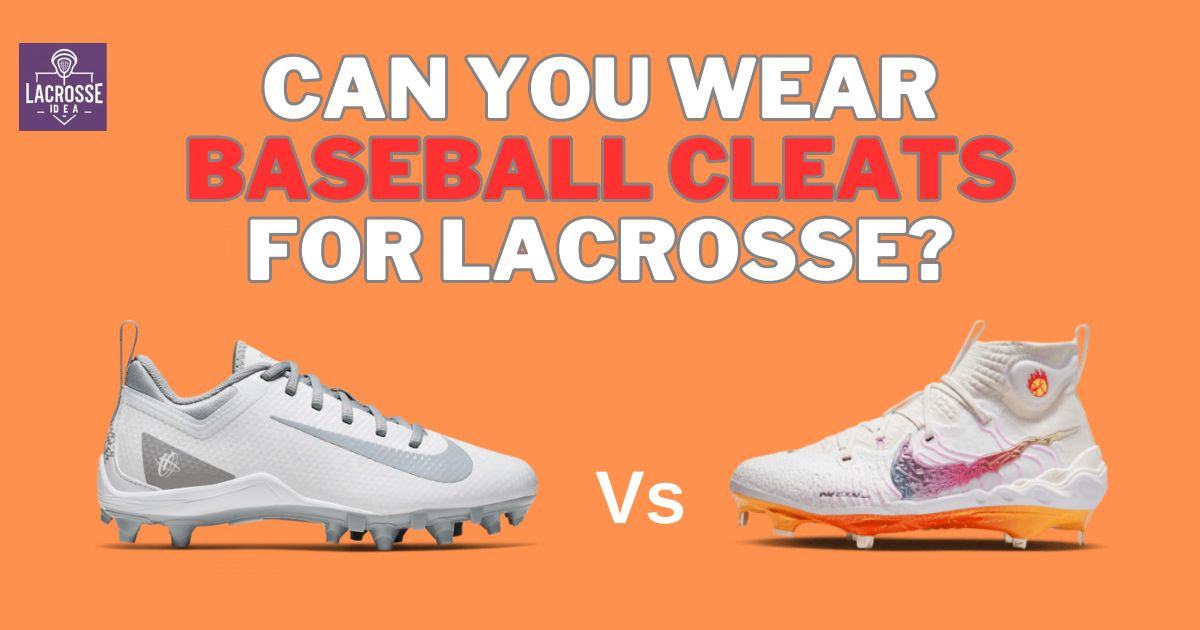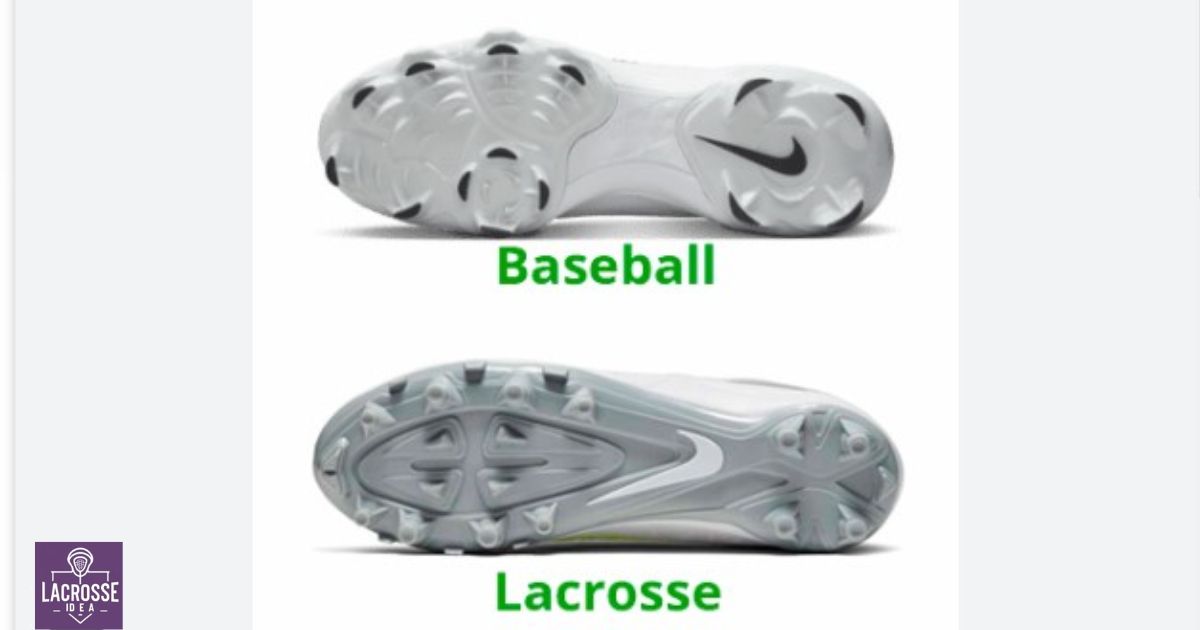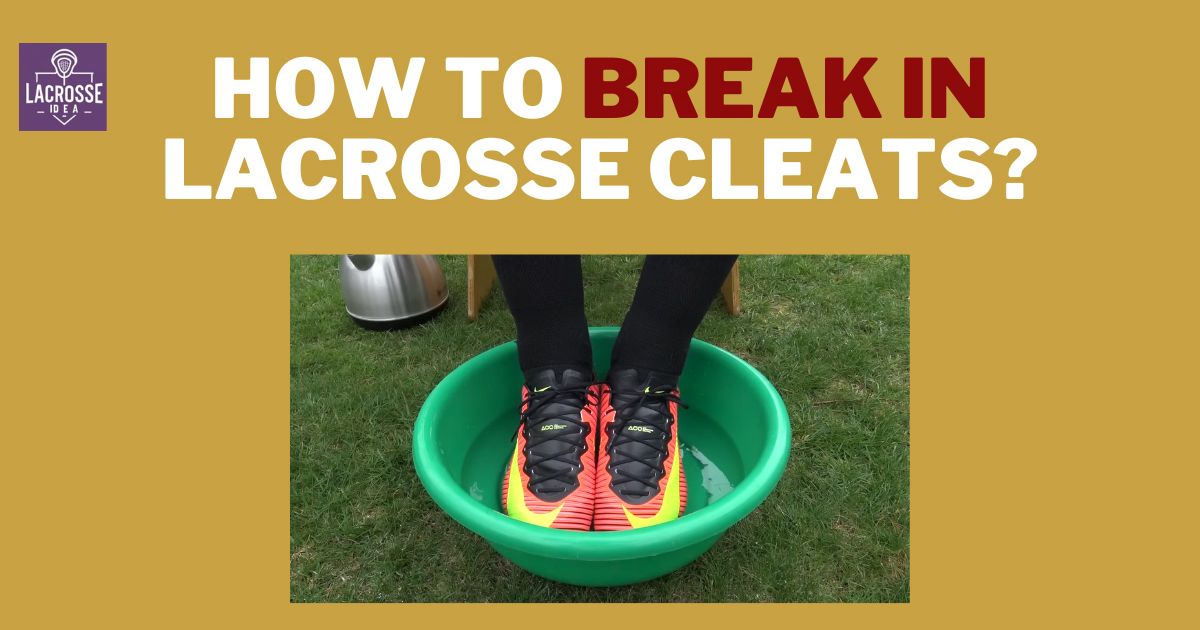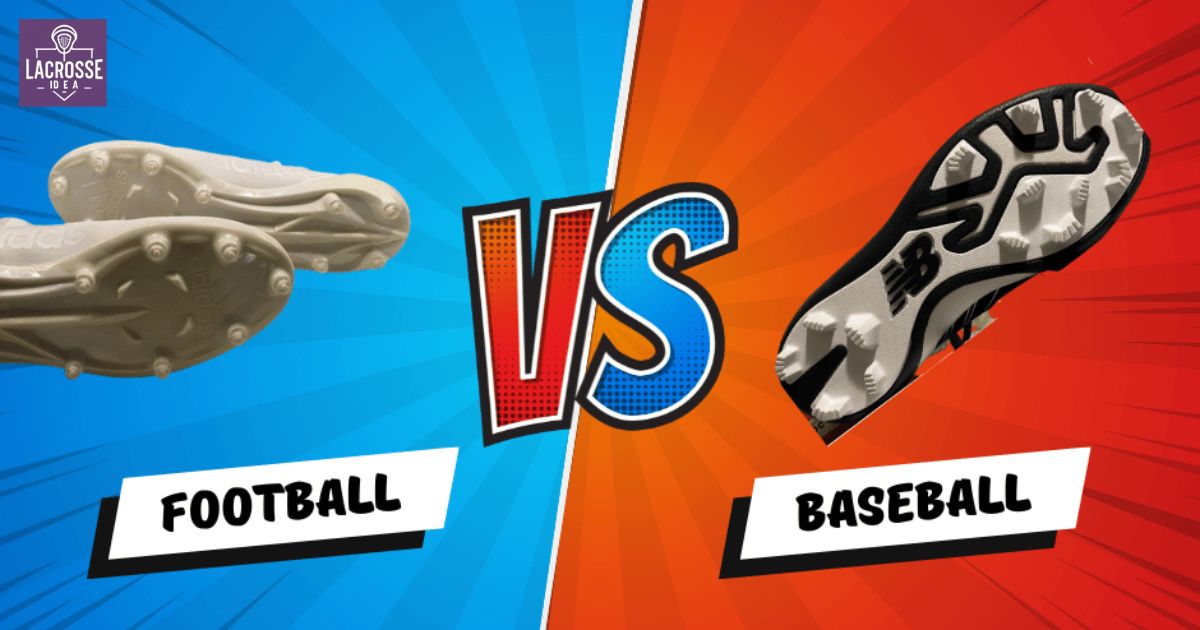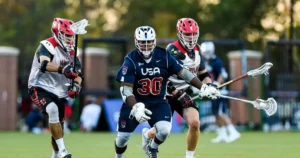In a sport where precision and agility are paramount, one might think that any type of cleat would suffice. However, when it comes to lacrosse, the choice of footwear can make all the difference. Surprisingly, baseball cleats may not be the ideal choice for lacrosse. This article explores the design differences between baseball and lacrosse cleats, and delves into the suitability of other cleat options for the game. Join us as we uncover the importance of selecting the right cleats for lacrosse, and perhaps, find the perfect fit for your game.
Key Takeaways
- Baseball cleats have metal spikes or rubber studs on the outsole for traction on grass and dirt surfaces, while lacrosse cleats have shorter and more numerous studs for maximum traction on turf fields.
- Baseball cleats prioritize flexibility for running, while lacrosse cleats have a stiffer construction for stability and to prevent ankle rolls.
- Lacrosse cleats typically have higher ankle support to protect against injuries during the fast-paced nature of the game.
- Baseball turf shoes may not offer the same level of grip, ankle support, and specific patterns optimized for lateral cuts and quick accelerations that lacrosse cleats provide.
Design Differences
Baseball cleats and lacrosse cleats differ in their design features, making them distinct in terms of their functionality and performance on the field. Baseball cleats are designed to provide players with traction on the diamond, allowing them to run, pivot, and slide with ease. They typically have metal spikes or rubber studs on the outsole to grip the grass and dirt surfaces.
On the other hand, lacrosse cleats are specifically engineered to support the quick and agile movements required in the game. They feature shorter and more numerous studs or cleats to provide maximum traction on the turf field. The design differences between baseball cleats and lacrosse cleats are crucial for players to perform at their best and adapt to the specific demands of their respective sports.
Transitioning into the subsequent section about baseball cleats vs. lacrosse cleats, it is important to examine the materials used in their construction and how it affects their performance.
Baseball Cleats Vs. Lacrosse Cleats
When comparing baseball cleats to lacrosse cleats, it is important to consider their distinct features and how they impact performance on the field. Here are four key differences between the two:
- Traction: Lacrosse cleats are designed with smaller, more numerous studs to provide optimal traction on turf or grass surfaces, allowing players to make quick lateral movements and cuts.
- Ankle Support: Lacrosse cleats typically have higher ankle support to protect against ankle injuries that can occur during the fast-paced, physical nature of the game.
- Flexibility: Baseball cleats prioritize flexibility to facilitate running, whereas lacrosse cleats often have a stiffer construction to enhance stability and prevent ankle rolls.
- Weight: Lacrosse cleats are generally lighter than baseball cleats, ensuring agility without sacrificing durability.
Understanding these differences is crucial in determining the most suitable cleats for lacrosse.
Suitable Cleats For Lacrosse
Lacrosse requires specific cleats designed for the sport to ensure optimal performance and safety on the field. These cleats are specially made to provide the necessary traction, stability, and support required for the quick movements, sudden stops, and direction changes inherent in the game. Unlike other sports, lacrosse involves a unique combination of running, cutting, and lateral movements, making it essential to have cleats that can handle these demands.
When choosing cleats for lacrosse, it is important to consider factors such as the playing surface, player position, and personal preferences. For natural grass fields, molded cleats with medium-length studs are typically recommended, as they provide good traction without causing excessive turf damage. On artificial turf surfaces, cleats with shorter, rubber studs or turf-specific patterns are more suitable to ensure proper grip and prevent injury.
In addition to traction, lacrosse cleats should also offer sufficient ankle support to protect against sprains and twists. Many lacrosse cleats feature high-top designs or added ankle support features to provide stability during quick movements and changes in direction.
Can Baseball Turf Shoes Work?
Turf shoes designed for baseball may not be suitable for use in lacrosse due to the specific demands and requirements of the sport. While baseball turf shoes are designed to provide traction and support on artificial surfaces, they lack certain features that are necessary for lacrosse. Here are four reasons why baseball turf shoes may not work for lacrosse:
- Lack of ankle support: Lacrosse involves quick movements and changes in direction, requiring strong ankle support to prevent injuries. Baseball turf shoes typically have a low-cut design that may not provide sufficient ankle support.
- Insufficient grip: Lacrosse requires excellent traction to maneuver on grass or turf fields. Baseball turf shoes may not offer the same level of grip needed for quick cuts, dodges, and stops.
- Different cleat patterns: Lacrosse cleats have specific patterns designed for the sport’s movements, such as lateral cuts and quick accelerations. Baseball turf shoes may have different cleat patterns that are not optimized for lacrosse.
- Lack of protection: Lacrosse involves physical contact and stick checks, making it crucial to have shoes that offer protection. Baseball turf shoes may not have the necessary padding or reinforcement to withstand the rigors of lacrosse.
Girls And Boys Lacrosse Cleats
Girls and boys lacrosse cleats offer specific features and functionality that are essential for optimal performance and safety in the sport. Designed with the unique needs of lacrosse players in mind, these cleats provide the necessary traction, support, and stability required for quick movements and sudden changes in direction on the field. The cleats feature specialized outsoles with strategically placed studs or spikes that grip the playing surface, allowing players to maintain their balance and agility.
Additionally, lacrosse cleats often come with reinforced toe caps and ankle support to protect against injuries commonly associated with the sport. Furthermore, these cleats are available in a variety of styles and colors, allowing players to express their personal style and feel a sense of belonging to their team or community.
Baseball Cleats For Football
Baseball cleats can also be utilized for football, providing athletes with traction and stability on the field. Here are four reasons why football players can opt for baseball cleats:
- Versatility: Baseball cleats offer a versatile option for football players as they are designed for multiple surfaces. Whether it’s grass, turf, or even muddy conditions, baseball cleats can handle it all.
- Traction: The cleats on baseball shoes are designed to dig into the ground, providing excellent traction. This is crucial for football players who need to make quick cuts, change direction, and maintain balance during gameplay.
- Stability: The sturdiness of baseball cleats ensures stability, reducing the risk of ankle injuries. Football players can rely on the support and structure provided by these cleats, enhancing their performance on the field.
- Cost-effectiveness: Baseball cleats tend to be more affordable compared to specialized football cleats. This makes them a practical choice for athletes who are on a budget or play multiple sports.
Breaking In Lacrosse Cleats
Lacrosse cleats, like their baseball counterparts, require a proper break-in process to ensure optimal performance on the field. Breaking in lacrosse cleats is essential to avoid discomfort, blisters, and potential injuries during gameplay. To break in your lacrosse cleats, start by wearing them around the house for short periods to allow the materials to flex and mold to your feet.
Gradually increase the time spent wearing them, and then move on to practicing on soft surfaces, such as grass or turf, before using them in games or intense training sessions. This gradual process will allow the cleats to adapt to your feet, providing maximum comfort and support. Once your lacrosse cleats are broken in, you’ll be ready to hit the field with confidence and agility.
Now, let’s move on to identifying baseball cleats, which can be a suitable alternative for lacrosse players.
Identifying Baseball Cleats
Baseball cleats can be distinguished from other types of cleats by their specific design features and construction. Here are four key characteristics that help identify baseball cleats:
- Cleat Configuration: Baseball cleats typically have metal or molded spikes on the outsole, providing excellent traction on dirt and grass surfaces. The spikes are strategically placed to enhance grip and stability during quick movements.
- Toe Cleats: Baseball cleats often have an additional cleat at the front of the shoe, called a toe cleat. This extra spike aids in digging into the batter’s box, providing a solid base for powerful swings.
- Midsole Cushioning: Baseball cleats prioritize comfort and support. They usually feature ample midsole cushioning to absorb shock and alleviate pressure on the feet during the game.
- Cleat Material: Baseball cleats are commonly made of durable materials like leather or synthetic materials, ensuring longevity and foot protection throughout the season.
Ideal Cleats For Lacrosse
Based on the distinctive features of baseball cleats, it becomes crucial to explore the characteristics of ideal cleats for lacrosse. Lacrosse is a fast-paced and dynamic sport that requires agility, traction, and support. Therefore, the ideal cleats for lacrosse should possess certain key features. Firstly, they should have a low-profile design to promote quick movements and prevent ankle injuries. Additionally, lacrosse cleats should have a sturdy outsole with multidirectional studs to ensure excellent traction on various playing surfaces.
Furthermore, they should offer ample cushioning and support to withstand the physical demands of the sport. Lastly, lacrosse cleats should prioritize breathability to keep the feet cool and dry throughout the game. Considering these factors, it is clear that lacrosse-specific cleats are the optimal choice for the sport. However, if lacrosse cleats are not readily available, there are alternative options that can be considered.
Alternatives To Baseball Cleats
One possible alternative to baseball cleats for lacrosse is to consider soccer cleats. While they may not be specifically designed for lacrosse, soccer cleats offer several advantages that make them a viable option for players. Here are some reasons why soccer cleats can be a good alternative:
- Traction: Soccer cleats are known for their multidirectional traction, which allows players to make quick cuts and changes in direction on the field.
- Lightweight: Soccer cleats are typically lighter than baseball cleats, providing players with increased agility and speed.
- Comfort: Soccer cleats are designed to provide comfort and support during long matches, making them suitable for the demands of lacrosse.
- Versatility: Soccer cleats can be used on a variety of playing surfaces, including grass, turf, and even artificial turf, making them versatile for different lacrosse field conditions.
Ultimately, while baseball cleats may not be the ideal choice for lacrosse, soccer cleats can offer a suitable alternative that meets the needs of lacrosse players.
Soccer Cleats For Lacrosse
Soccer cleats offer a viable alternative for lacrosse players due to their multidirectional traction, lightweight construction, and comfort during matches. Lacrosse is a sport that requires quick changes in direction and agility, and soccer cleats are designed to provide the necessary traction for these movements. The studs or blades on soccer cleats allow for better grip on the field, enabling players to make sharp turns and sudden stops.
Additionally, soccer cleats are typically lighter than other types of cleats, which can enhance a player’s speed and agility on the lacrosse field. Moreover, soccer cleats are designed with comfort in mind, often featuring cushioning and support to keep players comfortable throughout the game. Overall, soccer cleats can be a suitable choice for lacrosse players, offering the necessary performance and comfort for optimal gameplay.
Baseball Vs. Football Cleats
When comparing baseball and football cleats for lacrosse, it is important to consider their design and traction capabilities. Here are the key differences between baseball and football cleats:
- Design: Baseball cleats typically have a low-top design, providing ankle mobility and flexibility for quick movements. On the other hand, football cleats are high-top, offering more ankle support and stability.
- Traction: Baseball cleats have metal or molded plastic spikes, designed for gripping the grass and dirt on a baseball field. Football cleats, on the other hand, have shorter, more numerous spikes to provide traction on turf or grass.
- Sole thickness: Baseball cleats have a thinner sole to allow players to feel the ground and make quick movements. Football cleats have a thicker sole to absorb impact from tackles and provide stability on different surfaces.
- Weight: Baseball cleats are usually lighter to enhance speed and agility, while football cleats tend to be heavier for added durability and protection.
Understanding these differences is crucial when choosing the right cleat for lacrosse. Now, let’s delve into the compatibility of different sports with cleats.
Sports And Cleat Compatibility
To determine the compatibility of baseball cleats with lacrosse, it is essential to consider the versatility of cleats across different sports. While baseball and lacrosse are distinct sports with unique playing conditions and footwear requirements, there is some overlap in the functionality of their cleats. Both sports involve quick lateral movements and require traction on grass or turf surfaces. Baseball cleats are designed to provide stability and traction on the diamond, with metal or molded spikes that dig into the ground.
Lacrosse cleats, on the other hand, are designed for the demands of the lacrosse field, with rubber or molded spikes that offer traction and support during fast-paced gameplay. While baseball cleats can be used for lacrosse in a pinch, it is recommended to use sport-specific cleats to maximize performance and reduce the risk of injury.
Importance Of Cleats In Lacrosse
Cleats play a crucial role in lacrosse, providing necessary traction and support for players on the field. Having the right pair of cleats can greatly enhance a player’s performance and reduce the risk of injury. Here are four reasons why cleats are important in lacrosse:
- Traction: Lacrosse is a fast-paced game that requires quick movements and changes in direction. Cleats with specialized spikes or studs help players maintain traction on the field, preventing slips and falls.
- Stability: The nature of lacrosse involves physical contact and aggressive play. Cleats with proper ankle support and stability features help players stay balanced and avoid ankle injuries.
- Durability: Lacrosse is played on various surfaces, including grass, turf, and sometimes even mud. High-quality cleats are designed to withstand these conditions and provide long-lasting performance.
- Performance: The right pair of cleats can improve a player’s speed and agility, allowing them to make quick cuts and accelerate faster. This can give players a competitive edge and help them excel on the field.
Investing in a good pair of lacrosse cleats is essential for any player looking to perform at their best and stay safe while playing the game.
Frequently Asked Questions
Can I Use Soccer Cleats for Lacrosse?
Soccer cleats can be used for lacrosse, as they provide similar traction and support. However, it is important to note that lacrosse cleats are specifically designed for the sport, offering additional ankle support and durability.
Are Lacrosse Cleats Only for Professional Players?
Lacrosse cleats are not exclusively reserved for professional players. They are designed to provide the necessary traction, support, and stability required for the sport. Whether you are a beginner or a professional player, investing in proper lacrosse cleats is essential.
Can I Wear Lacrosse Cleats for Other Sports?
Yes, lacrosse cleats can be used for other sports such as soccer or field hockey. However, baseball cleats may not be suitable for lacrosse due to differences in traction and support needed for the sport’s unique movements and playing surface.
Can Baseball Cleats Be Used for Other Field Sports Besides Football?
Baseball cleats are designed specifically for the sport of baseball, offering traction and stability on the diamond. While they may be suitable for other field sports like football, their effectiveness in sports like lacrosse may be limited due to different playing surfaces and movement patterns.
Are There Any Specific Cleats Recommended for Indoor Lacrosse?
When considering the specific cleats recommended for indoor lacrosse, it is important to prioritize safety and performance. While baseball cleats may offer some traction, lacrosse cleats are designed to enhance agility and provide optimal support on the lacrosse field.
Conclusion
In conclusion, while baseball cleats may share some similarities with lacrosse cleats, there are design differences that make them less suitable for lacrosse. Lacrosse cleats offer specific features such as ankle support, traction, and flexibility that are essential for the demands of the game.
Soccer cleats can be a suitable alternative, but it is important to choose cleats specifically designed for lacrosse to ensure optimal performance and safety on the field. The right cleats are like the perfect tool, enabling players to navigate the terrain and excel in the game of lacrosse.
